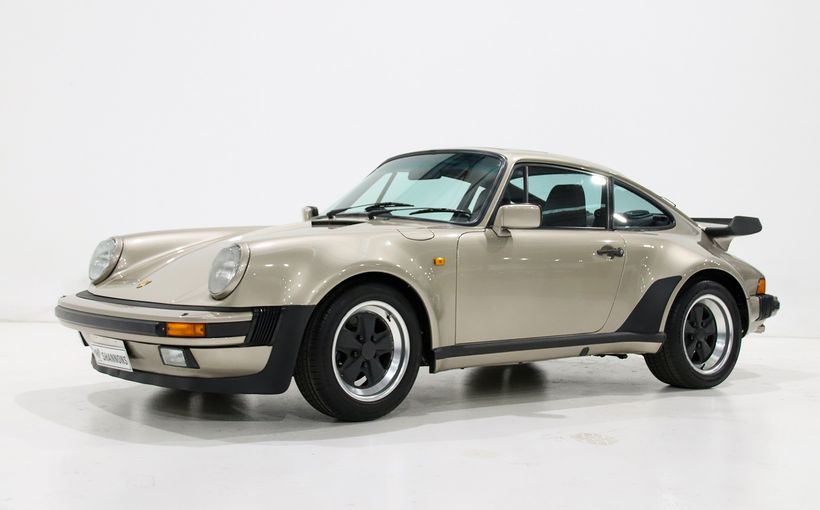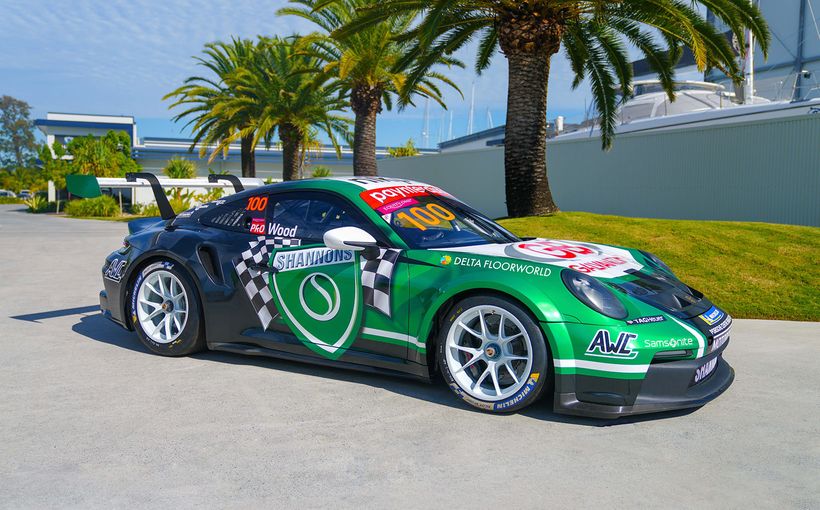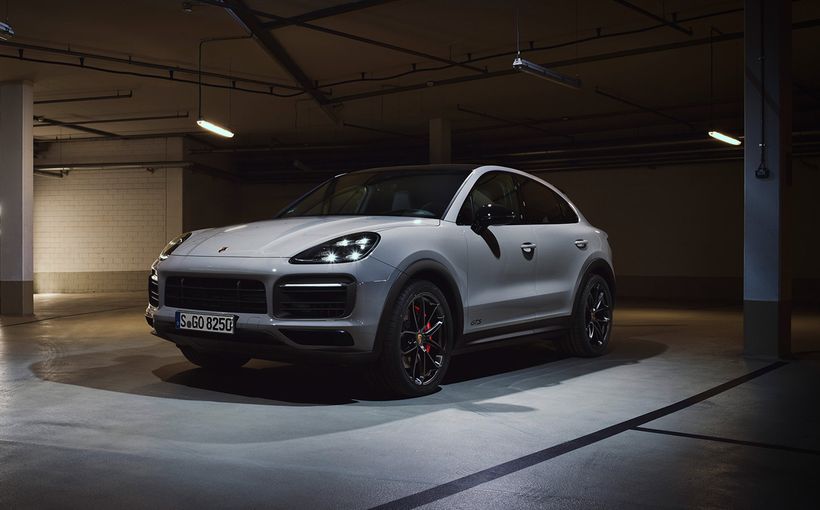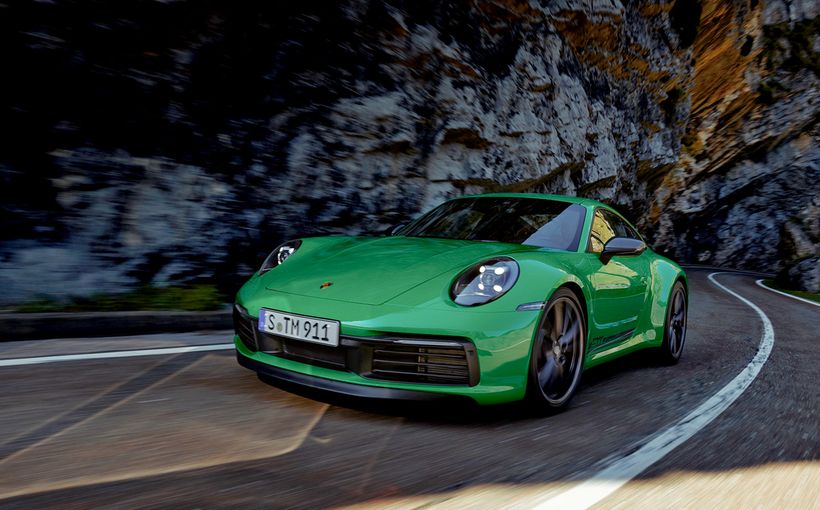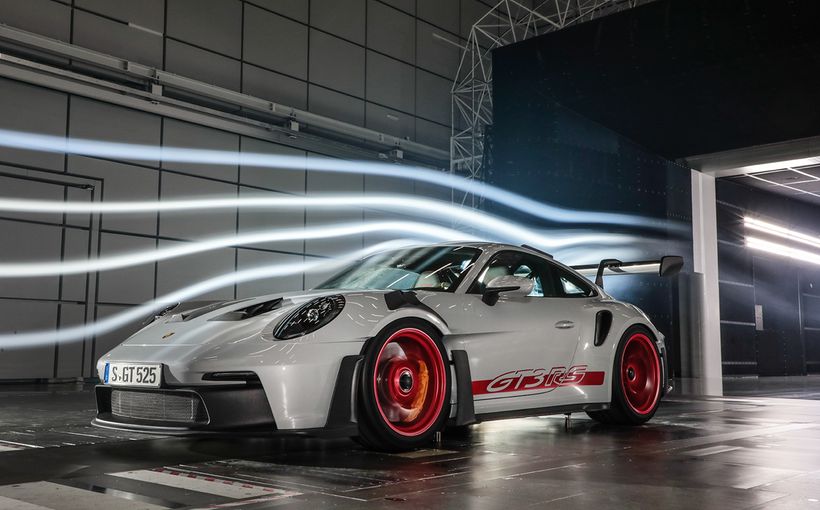Porsche 911 Turbo: Green Grosser

THE 911 TURBO is back. Sixteen months after the old model stopped production, a new version of the whaletail coupe is about to hit the streets. Although the shape hasn't changed much, more than 85 per cent of the components are new, largely because the 1991 Turbo is base, on the much-improved new 911, the Carrera 2.
But one thing hasn't changed: the Turbo is still the fastest Porsche you can buy. It's also the most expensive-Porsche Australia will this year import only 10 cars, at $281,000 each. Our test car - the first production 911 Turbo-was a crowd-puller par excellence. Not only because of the shape, but the colour, too.
Described b Porsche as "reseda green", this verdant hue is one of three controversial new colours chief designer Harm Lagaay has created for the '91 season. Also new are a very pink "amazing violet" and a zinc white-cum-yellow reminiscent of an early Carrera RS colour.
The shape of the ne Turbo is more closely related to its predecessor than the Carrera 2's is to the original 911. The Turbo not only retains its legendary full-size rear wing, it again boasts generously flared wheelarches. Somehow, the plastic bumpers and sill extensions are more compatible with the wide-body design than the Carrera 2, which is two inches slimmer at the front and almost five inches narrower at the back. Other changes include low-drag door mirrors, two exhaust tailpipes, and a set of 959-style five spoke forged alloy wheels.
The Turb sit on a lowered suspension, but the extra width creates a larger frontal area. The drag coefficient also suffers from the fatter tyres and massive tail rudder, which does not withdraw at low speed like the Carrera 2's pop-up spoiler. As a result, the drag figure increases from 0.33 to a below-average 0.37.
The Porsche engineers know they could have done better in the wind tunnel, but they deliberately neglected the Cd issue in favour of reducing axle lift. Unlike the old car, the new Turbo features a bonded-in windscreen, better drip rails and a virtually flush floorpan.

There are two reasons why the whaletail rear spoiler has not changed: first, it must accommodate an even bigger intercooler for which there isn't enough room in the engine bay and, second, the over-size tail fin greatly contributes to the car's directional stability at speed.
Inside, the latest Turbo suffers from the same generic faults as the Carrera 2. True, the heater and ventilation controls have been improved, and the seats are now fully power operated. But the dials are still partly obscured by the non-adjustable steering wheel, the secondary switchgear seems to be positioned at random, and the chairs don't offer a lot of support unless you are of beefy Germanic stature.
The five round instruments are not quite as logical and legible as they used to be. The clock, for instance, houses no fewer than 12 warning lights, and the rev counter accommodates a stalk-operated computer that displays a wide variety of information, including boost pressure, ambient temperature and fuel consumption.
The test car was equipped with optional airbags for driver and passenger. These devices can undoubtedly be useful, but unfortunately their installation entails a miniature glovebox, an ungainly steering wheel hub and a full-width knee bolster that restricts legroom for tall people. The standard equipment is generous, as it should be on a car costing so much.
Included in the price is power for windows, door locks, seats and mirrors. Temperature-controlled air-conditioning, music, fold-forward rear seats and tinted glass. Just about the only extras you can get are metallic paint, sunroof, leather interior, airbags, a premium sound system with CD player and a limited-slip diff.
The 911 Turbo cannot be had with the Tiptronic automatic transmission, and it isn't offered with the four-wheel drive system of the Carrera 4, either. The blown engine makes it impossible to squeeze in the 4WD hardware.
To cope with the higher power output and the greater width, Porsche fitted more substantial, reinforced semi-trailing arms as well as wider wheels and rims. There is only one wheel and tyre combination available (205/50ZR 17 front, 255/40ZR17 rear), but the customer can still choose from three different rubber patterns supplied by Bridgestone, Pirelli or Yokohama.

All 911 Turbos come with a revised suspension set-up of stiffer dampers, tauter coil springs and spring struts, plus fatter anti-roll bars. Bigger anti-lock brakes were installed to ensure that 80 km/h-tozero just about equals zero-to-80 km/h; the swept area of the drilled and ventilated discs is up 13 per cent.
Another novelty for hard core Turbo drivers is the power assisted rack and pinion steering that is properly damped and doesn't require the arms of Superman for parking manoeuvres. The five speed gearbox relies on freshly staggered ratios and a modified shift.
Unlike the Carrera 2/4, the Turbo retains the old 3.3 litre flat six that has been around since 1977. Porsche had problems uprating this engine - that's why Turbo production was suspended for almost two years. In catalyst-equipped form, the previous generation Turbo produced a mere 213 kW - only 26 kW more than the more modern 3.6 litre Carrera engine.
To catch up, Porsche decided to develop a thoroughly modified derivative of the faithful 3.3 litre unit. Of course, the Weissach power brokers would have preferred to use the new 3.6 as the base engine. But time and money were tight, and since there was already a worksprepared 246 kW edition available to wealthy, power hungry customers, it made more sense to convert this special-order engine to catalyst operation.
While bore and stroke were left untouched, chief powertrain engineer Paul Hensler first of all fitted a new free flow intake manifold and a matching exhaust system. Second, the engineers added a tailor-made electronic ignition system and Bosch K-Jetronic injection. Next, they equipped the air cooled two valve boxer with a bigger KKK turbocharger and a larger air-to-air intercooler.
Although the maximum boost pressure was reduced slightly from 0.8 to 0.7 bar, the thermodynamic efficiency, the flow pattern, the exhaust emissions and the mid-range fuel consumption were significantly improved. A redesigned turbo impeller also quickens throttle response at low engine speeds. Other noteworthy changes include a more efficient all-metal catalyst, a double mass flywheel that acts as a noise and vibration damper, and a wastegate tailpipe that prevents the exhaust gas from re-entering the system ahead of the main converter, thus minimising the back pressure power loss.
The revamped turbo engine produces 238 kW at 5750 rpm and 440 Nm at 4500 rpm. The 1989 non-catalytic Turbo delivered 223 kW and 421 Nm, and the Carrera 2 musters 186 kW and 343 Nm. Let's also compare the performance and fuel consumption figures. The 1991 Turbo will storm in 4.8 secs from 0-100 km/h, top 270 km/h and average 13.3L/100 km. The data for the 223 kW model are 5.0 secs, 262 km/h and 12.7 L/100 km/h, and the Carrera 2 will achieve 5. 7 sec, 262 km/h and 11.9 L/100 km/h.

The Turbo's exhaust note lacks the melodious roar of a Testarossa, the beautiful bellow of an NSX and the well-mannered growl of a 500SL. This is a shirt-sleeved, churlish, unrestrained and very mechanical powerplant. The Turbo whine, valve clatter, compressor cut-in and camshaft rattle ring through loud and clear. It idles unevenly and screams like a chainsaw when you floor the throttle.
As with all 911 s, the engine presentation is appalling. All that matters to Porsche is that the Turbo produces lots of power, and outlasts all these shiny, but fragile, multi-valve masterpieces that compete with the 911. Despite the numerous changes and improvements, the new Turbo preserves at least part of the old Jekyll and Hyde character. Around town, this engine is positively toothless - unless, of course, you prefer to frighten neighbours and pedestrians by unleashing 320 horses within the city limits.
Below 3000 rpm, the turbocharger is asleep, and the digital boost gauge readout confirms this. Use the throttle gently, and you will understand why the new 911 Turbo meets even the tough Swiss noise legislation, and why it will return 8.5 L/100 km at a steady 90 km/h.
The clutch is now light and progressive, but the slightly sticky throttle still doesn't respond well. Take-off at anything below 3500 rpm is a positively sedate affair, and even at higher revs there is a small delay before the turbocharger cuts in. The communication between accelerator and engine is smoother than before, but it is not as fluent and progressive as in the normally aspirated Carrera 2.
In most driving conditions, turbo lag isn't a serious problem because the power reservoir is deep enough to iron out the hiccups. But at the limit, when the car is dancing through the corner on the razor's edge, this moment of doubt can take away all the fun.
In the old Turbo, this black and white throttle response was matched by black and white chassis behaviour; it didn't take much to upset the delicate handling balance. But the chassis of the new model is so good that it now requires a serious effort to kick out the tail. To cure the notorious oversteer, Porsche fitted state of the art underpinnings plus sports shocks and springs, wider and bigger tyres and more sensitive steering.
The 1991 Turbo sticks like glue, runs through corners as if on rails, and turns in with the obedience of a slot racer. Initial understeer gives way to neutral behaviour as you press on, and then nothing dramatic will happen for a long, long time. In the wet and through a first or second gear bend, full throttle will still induce a little tail-happiness.
But in the dry you must take your heart in both hands to get some action out of this Porsche. At least initially, the lift-off-turn-inpress-on routine does not tempt the tail to come around. Roadholding and grip are so overwhelming that they defeat the pendulous efforts of the rear engine configuration. Beating the system requires a notably higher entrance speed and a more determined manoeuvre at the wheel. But be careful - the turbocharger acts like a slow motion whip. At full boost, it provides the biggest push when you least need it - through the final section of the corner.




In the old 911, this hearty pat on the backside had to be treated with great caution. Thankfully, the new car is much more civilised. It has greater staying power, and it is also more forgiving. If you do get the tail out, a moderate dose of opposite lock will usually set the car straight again without snapping back.
But not even this well-educated behaviour can obscure the disappointment of the clash between a super suspension and the ageing, insufficiently responsive engine. The turbo motor provides plenty of top end, but the normally aspirated unit is without a doubt a more even solution. The forthcoming Carrera RS will soon prove it.
Despite this one serious flaw, the 911 Turbo does stir up the adrenalin like very few sports cars. First of all, it is very fast. On secondary roads, it takes a conscious effort not to exceed the speed limit. Overtaking is the easiest trick in the book because you can safely use gaps the driver of a Golf GTi or a BMW 325i wouldn't even consider.
The accelerative potential in second and third is simply incredible, the huge disc brakes arrest the 1485 kg 2+2 seater with just as much force, and the power-assisted steering provides a degree of precision drivers of older Turbos can only dream of. This car does, in other words, handle, brake and steer so well that it can - and probably soon will - cope with more than the current 238 kW.
Of course there is always room for improvement. The 911 badly needs a modern dashboard featuring better ergonomics, and it could do with more supportive seats, classier cabin trim, and decent speakers. Ride comfort, wind noise and tyre roar are all below par, although by supercar standards the Turbo doesn't fare too badly.
There is also a question mark behind the fuel consumption. Our test car returned a sobering 27.2 U100 km, which is quite poor even when hard driving is taken into account. Still on the debit side, the gearbox could do with a stronger detent to prevent accidentally engaging reverse. The final criticism concerns the rev limiter which cuts in at 6800 rpm with such machine-gun vengeance that you will never touch it again!
In many ways the Turbo is not significantly superior to the Carrera 2. True, it accelerates harder, goes faster and grips better. But is that enough to justify such a price difference? It's the engine we must blame. It is thirstier and notably less responsive than its normally aspirated sibling. And untimely throttle lag makes it difficult to get the best out of a truly exceptional chassis.

Protect your Porsche. Call Shannons Insurance on 13 46 46 to get a quote today.



